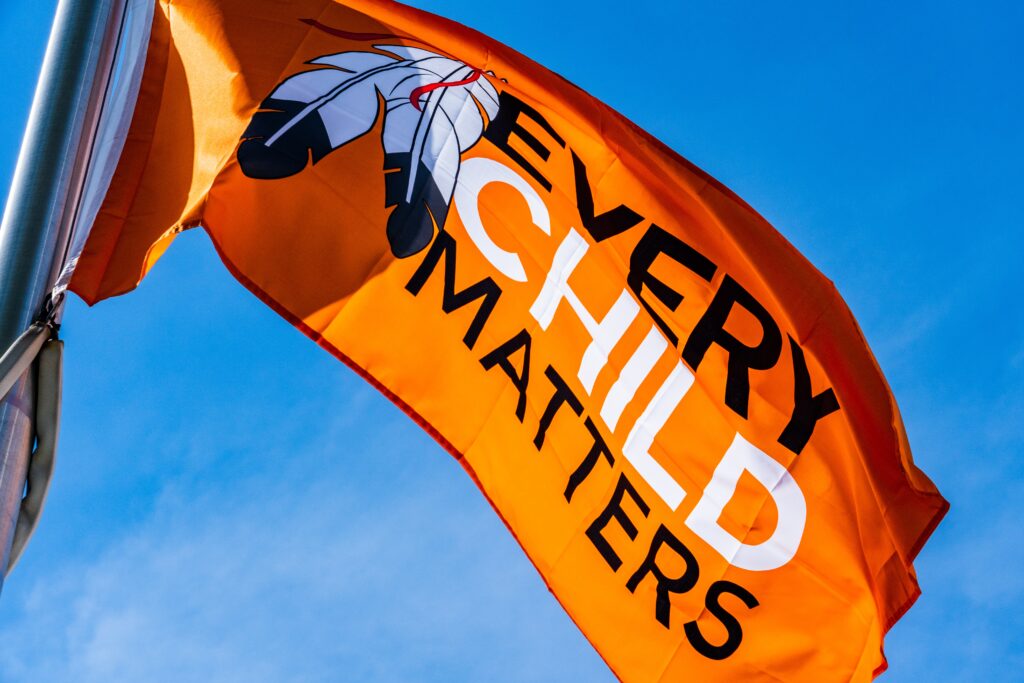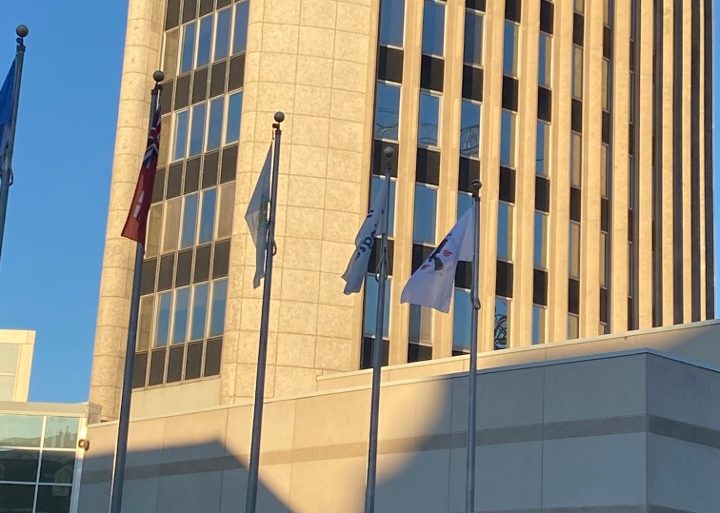By Leena Sharma Seth
National Indigenous History Month is upon us! I’m looking forward to all of the opportunities I will have as a settler on this land, to continue to learn about how we got to this present moment, preferably from the Indigenous perspective, and to continue to deepen my commitments to Truth and Reconciliation.
I had the privilege of learning from Gimaa (ogimaa means “Chief” in Ojibway) Stacey Laforme of the Mississaugas of the Credit First Nation recently and something he said stayed with me. Gimaa talked about the uncovering of Indigenous children’s graves just over two years ago in Tk’emlúps te Secwépemc, B.C. and offered a powerful reframe: “These were not just our children’s graves that were uncovered [as in Indigenous community’s children] but our children, as in Canada’s children.”
I felt that deeply. What healing and justice would become possible if we could feel the pain of the loss of these children as if they were our own children? And what if we could deeply understand the harm Indigenous communities have endured because of racist and anti-Indigenous policies and actions, as if they were our own grandmothers, grandfathers, mothers, fathers, uncles, aunts, and cousins who were affected? How would our actions and commitments to supporting Indigenous self-determination, healing, justice and the land back movement look if this was the case?

Until we understand the “truth” half of the phrase “Truth and Reconciliation,” until we understand and acknowledge what was and continues to be done to Indigenous peoples, and recognize our present-day complicity/silence in the face of ongoing oppression and injustice, we don’t get to skip over to reconciliation. That would be the same as asking for forgiveness in an apology process without first taking the time to understand what harm happened and your role in it.
If we ever hope to see a functional relationship between this country and its First Nations people, it has to grow from honesty and understanding — the basis cannot be a lie. Laying that foundation will require Canada to face up to what it is, what it has always been. It will require this country to listen to the stories that Indigenous people have been telling for more than 150 years. It will require truth.
Jesse Wente, Unreconciled: Family, Truth and Indigenous Resistance, 2021.
How do we get to the truth, then, in Truth and Reconciliation? What can you do this National Indigenous History Month to learn more about that truth? Here are five things you can do this month to actively engage in Truth and Reconciliation:
- Read the Truth and Reconciliation Commission’s 94 Calls to Action. These actionable policy recommendations came out of a deep community consultation process that took place from 2007 to 2015 and gave Indigenous peoples across Canada the space to be witnessed as they shared stories of the horrific violence, dehumanization, and cultural genocide they survived (and many didn’t).
These Calls to Action should be required reading for every Canadian; if we had done our homework and respected the sacred stories that were shared in the consultation process, we would know that Calls 71 to 76 were dedicated to locating and preserving the sites where thousands of Indigenous children’s bodies were buried.
The outrage and shock of many Canadians who apparently learned for the first time that many residential schools had unmarked graves of countless Indigenous children was insulting to Indigenous communities who have been asking for justice since the day their children did not return home.
It’s a deep privilege to live in ignorance of the pain, trauma, and harm that members of our community have faced for centuries and continue to experience today, as evidenced by poor health outcomes, and Indigenous overrepresentation in the justice system and child welfare system. We are quick to see these types of statistics as signs that there is something defective or wrong with the communities, but as Resmaa Menakem correctly notes, people and communities are not defective; systems are where the defect lies.
The National Centre for Truth and Reconciliation (University of Manitoba) website houses over 5 million records that were captured during the consultation process and also hosts many reports that Canadians can access to continue to educate themselves.

- Educate yourself on exactly whose land you’re on. Visit www.native-land.ca to look up which First Nations, Inuit, and/or Métis people’s land you live on. This is a fabulous resource created by Indigenous leaders in Canada. The team states that “Native Land Digital aims to promote discussions surrounding the history of colonialism, Indigenous knowledge, and relationships between settlers and Indigenous communities.”
They achieve this through educational tools like the map and their Territory Acknowledgement Guide. Their goal is to move beyond traditional narratives about Indigenous peoples and establish a platform where Indigenous communities can share their stories and histories on their own terms.
- Put your money where your intentions are. I had the chance last year to get to know Patty Krawec, author of Becoming Kin, and interviewed her for a local cable show I co-hosted called Diverse Perspectives. I learned about the Nii’kinaaganaa Foundation and Patty’s “Pay Your Rent” fundraiser, which started in 2018 as an effort to bring menstrual supplies to Iqaluit and has since gone on to fund a host of projects benefitting Indigenous communities. You can donate to Pay Your Rent via PayPal or Patreon here.
When you invest in Indigenous arts, culture, and artifacts, do your homework, and make sure the artist, artisan, and/or business owner is actually Indigenous. Cultural appropriation is rampant in this space, with countless companies and businesses falsely claiming Indigeneity in an effort to cash in on current demand for Indigenous artifacts and to support Indigenous businesses. Cultural appropriation is harmful and exploitative and ultimately, your well-intentioned spend ends up not benefitting the communities you may be trying to support. For more information on the practice of falsely claiming Indigenous identity, I suggest the CBC Passionate Eye documentary The Pretendians.
Some Indigenous businesses I buy from include Future Kokum; Poppy and Peonies; Porcupine Kunik; Raven Reads; Cheekbone Beauty; Goodminds; Pow Wow Pitch (I buy the boxes when they come out each year and enjoy learning about new Indigenous businesses and products).

- Participate in local events celebrating National Indigenous History Month! On June 21, which is the summer solstice and National Indigenous People’s Day, commit to spending some time learning and being in community with Indigenous members of the Halton community. Research what’s happening in your local community, attend a Powwow, or plan to visit the Mohawk Institute (former residential school) and Woodland Cultural Centre. They also have a virtual tour in the event that getting to Brantford physically is not a possibility. And don’t just read about these events, actually get out and experience at least one. Move through any feelings of nervousness and discomfort and get out there and engage in these discussions, however imperfectly.
And better yet, take a friend or two. Talk about what you’re doing as a part of your personal commitments to Truth and Reconciliation. Use your influence and the relationships of trust you have to engage your community in conversations about Canada’s history, about Truth and Reconciliation and why this is important to you. In the words of writer Meg Wheatley, “Whatever the problem, community is the answer.” The harm happened in the community and so it goes that the healing can only happen in the community.
Truth and Reconciliation, after all, is not the work of Indigenous people, but the work of non-Indigenous people. This work is about progress, not perfection, and the sooner we liberate ourselves from the need to do things perfectly, the sooner we can get to the part where reconciliation and healing become an active reality in our community.
These are only some of the resources I will be immersing myself in this month, along with attending community events, and renewing my commitment to Truth and Reconciliation:
Podcasts
Stolen: Surviving St. Michael’s by former CBC journalist Connie Walker (2023 Pulitzer Prize and Peabody winner).
Medicine for the Resistance, by Patty Krawec and Kerry Goring.
I also want to acknowledge that this month we also celebrate amongst some of the communities being uplifted in June, Pride — the resilience, liberation, and right to love who we love. Celebrating resilience of communities at the margins must be intersectional as, in the words of American civil rights activist and women’s rights activist Fannie Lou Hamer, “Nobody’s free until everybody’s free.”
Leena Sharma Seth (she/her) is a settler and award-winning consultant, coach, trainer, and speaker at a firm she founded called Mending the Chasm. She works with businesses, organizations, and communities who are ready to create communities and workplaces that are inclusive, belonging-abundant, and safe for all members. When she’s not kicking at the darkness until it bleeds daylight, she’s enjoying road trips, 80s Bollywood music, and perfecting the art of baking cinnamon buns. She’s proud to call Burlington home and to be raising her children with her partner Sanjay.



